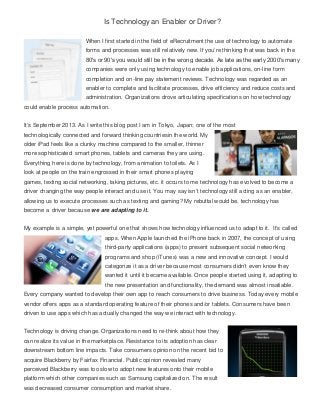Is Technology an Enabler or a Driver?
•
1 j'aime•489 vues
Signaler
Partager
Signaler
Partager
Télécharger pour lire hors ligne

Recommandé
Recommandé
Contenu connexe
Plus de Annzalie (Ann) Barrett
Plus de Annzalie (Ann) Barrett (10)
Building The Business case to Use social Media For Recruitment

Building The Business case to Use social Media For Recruitment
Have you embraced crowd sourcing to improve your brand

Have you embraced crowd sourcing to improve your brand
Talent Connect 13- What Recruiting Leaders Should Love Data

Talent Connect 13- What Recruiting Leaders Should Love Data
Talent connect 2012- Driving Company Engagement on LinkedIn

Talent connect 2012- Driving Company Engagement on LinkedIn
Dernier
Dernier (20)
Navigating the Deluge_ Dubai Floods and the Resilience of Dubai International...

Navigating the Deluge_ Dubai Floods and the Resilience of Dubai International...
Cloud Frontiers: A Deep Dive into Serverless Spatial Data and FME

Cloud Frontiers: A Deep Dive into Serverless Spatial Data and FME
ICT role in 21st century education and its challenges

ICT role in 21st century education and its challenges
Strategize a Smooth Tenant-to-tenant Migration and Copilot Takeoff

Strategize a Smooth Tenant-to-tenant Migration and Copilot Takeoff
Mcleodganj Call Girls 🥰 8617370543 Service Offer VIP Hot Model

Mcleodganj Call Girls 🥰 8617370543 Service Offer VIP Hot Model
Six Myths about Ontologies: The Basics of Formal Ontology

Six Myths about Ontologies: The Basics of Formal Ontology
Rising Above_ Dubai Floods and the Fortitude of Dubai International Airport.pdf

Rising Above_ Dubai Floods and the Fortitude of Dubai International Airport.pdf
Vector Search -An Introduction in Oracle Database 23ai.pptx

Vector Search -An Introduction in Oracle Database 23ai.pptx
"I see eyes in my soup": How Delivery Hero implemented the safety system for ...

"I see eyes in my soup": How Delivery Hero implemented the safety system for ...
Apidays New York 2024 - APIs in 2030: The Risk of Technological Sleepwalk by ...

Apidays New York 2024 - APIs in 2030: The Risk of Technological Sleepwalk by ...
Apidays New York 2024 - Scaling API-first by Ian Reasor and Radu Cotescu, Adobe

Apidays New York 2024 - Scaling API-first by Ian Reasor and Radu Cotescu, Adobe
Modular Monolith - a Practical Alternative to Microservices @ Devoxx UK 2024

Modular Monolith - a Practical Alternative to Microservices @ Devoxx UK 2024
Is Technology an Enabler or a Driver?
- 1. Is Technology an Enabler or Driver? When I first started in the field of eRecruitment the use of technology to automate forms and processes was still relatively new. If you’re thinking that was back in the 80′s or 90′s you would still be in the wrong decade. As late as the early 2000′s many companies were only using technology to enable job applications, on-line form completion and on-line pay statement reviews. Technology was regarded as an enabler to complete and facilitate processes, drive efficiency and reduce costs and administration. Organizations drove articulating specifications on how technology could enable process automation. It’s September 2013. As I write this blog post I am in Tokyo, Japan; one of the most technologically connected and forward thinking countriesin the world. My older iPad feels like a clunky machine compared to the smaller, thinner more sophisticated smart phones, tablets and cameras they are using. Everything here is done by technology, from animation to toilets. As I look at people on the train engrossed in their smart phones playing games, texting social networking, taking pictures, etc. it occurs to me technology has evolved to become a driver changing the way people interact and use it. You may say isn’t technology still acting as an enabler, allowing us to execute processes such as texting and gaming? My rebuttal would be, technology has become a driver because we are adapting to it. My example is a simple, yet powerful one that shows how technology influenced us to adapt to it. It’s called apps. When Apple launched the iPhone back in 2007, the concept of using third-party applications (apps) to present subsequent social networking programs and shop (iTunes) was a new and innovative concept. I would categorize it as a driver because most consumers didn’t even know they wanted it until it became available. Once people started using it, adapting to the new presentation and functionality, the demand was almost insatiable. Every company wanted to develop their own app to reach consumers to drive business. Today every mobile vendor offers apps as a standard operating feature of their phones and/or tablets. Consumers have been driven to use apps which has actually changed the way we interact with technology. Technology is driving change. Organizations need to re-think about how they can realize its value in the marketplace. Resistance to its adoption has clear downstream bottom line impacts. Take consumers opinion on the recent bid to acquire Blackberry by Fairfax Financial. Public opinion revealed many perceived Blackberry was too slow to adopt new features onto their mobile platform which other companies such as Samsung capitalized on. The result was decreased consumer consumption and market share.
- 2. How does this impact recruitment? Organizations also need to recognize the significance technology is playing in the attraction and retention of talent. For example, we know that the usage of mobile devices will continue to grow as the primary way people access the internet and information. We can infer the absence of a mobile strategy will exclude larger percentages of the population interacting with your brand. As social networking tools become a more dominant way to learn about employers, interact with them and read reviews on what others say about them, recruitment and talent functions will need to embrace these tools as a relevant and meaningful ways to engage and communicate. If your organization isn’t doing it, your competitor will. By Ann Barrett, Director eRecruitment & Social Media Strategy
